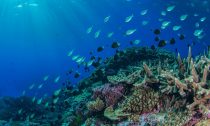
It’s no secret that global warming is bringing dramatic changes to coral reef ecosystems. Scientists have widely believed that habitat loss caused by coral death has the biggest effect on reef fish and invertebrates. Changes caused by warm water are actually faster and more widespread than the effects of habitat loss.Now new research has found that reef fish populations shift in direct response to the temperature itself and that changes caused by warm water are actually faster and more widespread than the effects of habitat loss.
The findings are significant for coral reef protection because a loss of biodiversity, especially of fish that eat harmful algae, could make it harder for reefs to recover from heat waves.
“I was surprised by how dramatic the response was over such a short time period,” said Chris Brown, a marine ecologist with the Australian Rivers Institute at Griffith University in Queensland who coauthored the paper. The paper was published online on 25 July in Nature.
Clues in a 2016 Heat Wave
The research looks at the effects of a marine heat wave that hit the Australian Great Barrier Reef in 2016. During the event, temperatures in northern parts of the reef reached as high as 32°C, 2° to 3° higher than the average hottest summer temperatures for the area.
“While 32 degrees is experienced at some places like [Indonesia] and the Red Sea, it is unusually high by the standards of any coral reefs, let alone the Great Barrier Reef,” said lead author Rick Stuart-Smith, a marine ecologist with the Institute for Marine and Antarctic Studies at the University of Tasmania in Hobart, Australia.
Corals stressed by warm water can expel the microscopic plants that live in their tissues. The process turns the coral white, leading to the term “coral bleaching.” Coral can sometimes recover from bleaching events, but over long periods, they will die, eventually breaking down into rubble and sand.
For the study, the researchers looked at data from monitoring surveys—efforts that seek to count fish and invertebrate populations, as well as coral cover—at 186 sites along the Great Barrier Reef and at isolated reefs in the Coral Sea. They compared data obtained between 2010 and 2015 with surveys taken 8 to 12 months after the heat wave.
They found that although the reef saw a net loss of coral, those losses weren’t uniform. “It was actually quite patchy,” Brown said. However, changes in fish populations were consistent across the board, regardless of where coral died.
Fish populations and biodiversity declined in northern reefs, but they increased in cooler southern waters, so that southern reef communities more closely resembled northern ecosystems after the heat wave. Certain invertebrates, like sea urchins, saw a similar change. “Things just jumped to the south,” Brown said.
A Delicate Ecosystem Balance
Other studies have shown that coral loss does affect fish populations, and a few species in the new study, especially coral-eating species like butterfly fish, did see changes that were directly tied to coral loss, Brown noted.
But the warming waters likely triggered a series of effects, the researchers note. Larger fish may have migrated south; the northern fish that remained may have become weaker and more likely to be picked off by predators.
The scientists also looked at temperature preferences for the different species, indicated by the highest latitude where a particular fish is found and the latitude at which it is most abundant. They found that fish species that prefer cooler waters were more strongly affected by the heat wave and saw the biggest population shifts.
That’s bad news for coral because many algae-eating species, like parrotfish, prefer cooler water. “One of the groups that responded most strongly was herbivorous fish,” Brown said. These grazing species help prevent algae from covering stressed coral, so the loss of these fish could make it harder for reefs to recover from bleaching events than scientists previously realized.
Habitat Protection in a Warming Ocean
The paper points to the special importance of protecting reefs at cooler latitudes, which are likely to play an important role in preserving biodiversity as oceans warm.Brown said that the research could help guide efforts to protect coral reefs from climate change. The paper shows that warming will affect reefs differently at different latitudes and points to the special importance of protecting reefs at cooler latitudes, which are likely to play an important role in preserving biodiversity as oceans warm.
The research could also be used to inform fisheries management in making such decisions as restricting the take of parrotfish or other algae-eating species in areas that are most likely to see higher temperatures. Such protections could avoid making the problem worse, Brown noted.
Alastair Harborne, a reef fish ecologist with Florida International University in Miami who was not involved with the study, called the new paper especially noteworthy because of its large data set. The work, he noted, spanned a huge swath of the Great Barrier Reef, from tropical to subtropical waters.
The research also shows that climate change affects different parts of the fish community differently. “Some of those fish actually benefit in the south because they like warmer water, whereas in the north, if you’re closer to their thermal limits, just a little increase will have a big effect,” Harborne said.
He found it striking to see how fast fish populations could change. “What people haven’t talked about is how these short bursts of temperature seem to have a direct effect on fish,” he added. The research helps to start that conversation, he noted, showing results that he finds “surprising.”












Social Profiles